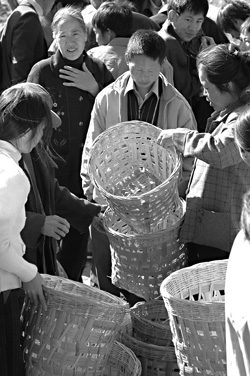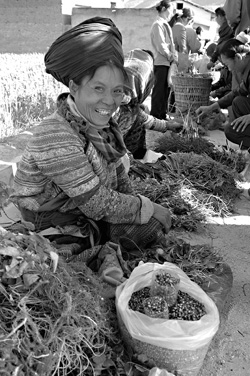|
Liangshan, Sichuan Province: The muddy path through Qianjing Village is usually quiet. But on Lantern Festival which falls on the 15th day of the Lunar New Year (February 12 this year), people from various directions will gather on this path to trade various farming utensils.
As rape flowers turn rural landscapes into a golden patchwork, another spring has arrived in the Badong Township of Dechang County, 70 kilometers to the south of Xichang, seat of the Liangshan Yi Autonomous Prefecture in Southwest China's Sichuan Province.
Specialized market
At the annual rural market, called Caochangba Fair, local people sell traditional instruments made of wood, bamboo, leather, palm fibre, hemp, iron and other materials. Barrels, hoes, ploughs and bamboo baskets are some of the most popular items.

Farmers choose bamboo baskets at the annual Caochangba Fair, a rural event held over Lantern Festival.
Such a rural market specializing in farm utensils is very rare in Southwest China.
Apart from the Han people, Yi and Lisu minorities also live in villages at the northern end of the Hengduan Mountains. At the rural fair, people dressed in their holiday best gather to exchange the latest farming techniques.

A woman sells herbs with medicinal properties at the Caochangba Fair in Dechang County, Southwest China's Sichuan Province.
Locals say the Caochangba Fair originated from early religious activities. Not far from Qianjing Village is a temple called Yudong. Legend has it that the temple was built in the early 16th century of the Ming Dynasty (1368-1644).
In front of the temple is a pagoda built in 1884 during the rule of Emperor Guangxu of the Qing Dynasty (1644-1911).
The temple used to be very famous in the region. Every year, numerous people came here to pay tribute to Buddha and the pagoda during Lantern Festival, which was another major festival following Spring Festival.
There used to be a small lake near the temple. Some folk opera troupes would perform on a boat in the lake, attracting huge crowds.
Besides visiting the temple, watching folk opera and admiring the flowers, another important activity for Lantern Festival was to get new farming tools. As more and more people brought homemade instruments to the temple, the Caochangba Fair gradually came into being.
In the past, most farmers got what they needed by exchanging what they had. However, this ancient custom has long been replaced by dealings in cash. During the "cultural revolution" (1966-76), the rural fair disappeared. It was only around the late 1980s when locals revived the market.
Although the small lake no longer exists, the local people have other means to enjoy themselves staging the dragon lantern dance, the yangko dance and folk songs contests. Along the path, some folk song singers would squat on the ground, singing to a small group of onlookers.
Long history
The history of agriculture dates back thousands of years in Dechang County.
According to "Historical Records" (Shi Ji) by Sima Qian (c. 145 or 135 - ? BC) of the Western Han Dynasty (206BC-AD24), Qiongdu County (ancient name of Dechang) had large expanses of farmland among which people settled down in villages and towns.
The local annals of Dechang also say that during the Qin and Han dynasties (221BC-AD220), the ancient people called Qiong had lived by herding cattle and planting crops.
The Qiong people were mentioned in Sima Qian's "Historical Records" and "History of Han" (Han Shu) written by Ban Gu (AD 32-92). They were one of the major ancient ethnic groups in Southwest China and once set up their own regime.
But as few other written records remain, people still don't know much about their culture which seemed to disappear all of a sudden in the Eastern Han Dynasty (AD25-220).
In the 1970s, archaeologists discovered some 200 huge stone tombs along the Anning River. From July to December of 2004, archaeologists in Sichuan Province excavated six such tombs to prevent them from being destroyed during the construction of a highway from Xichang to Panzhihua.
Facing east or west, the tombs' rectangular chambers were built with giant stone slabs.
They commonly measure 10 metres by three. The cover of the tombs is carved out of several large rocks that vary in size and weight.
Buried in the chambers are over 100 remains, but it appears that they were not buried together at the same time. Experts have found evidence to show that the bones were collected from elsewhere and then put into the chambers.
Gao Dalun, director of the Sichuan Archaeology Institute, said experts have agreed that these tombs belong to the Qiong people using evidence recorded in ancient books.
The six tombs excavated at Dezhou Town of Dechang County can be dated back to the time between the Warring States Period (770BC-476BC)and the Western Han Dynasty (475BC-AD24).
From another tomb excavated earlier, archaeologists found an iron spade dating back to the Eastern Han Dynasty (AD25-220).
Two characters "cheng du" (the capital of Sichuan) were engraved on the spade. Liu Hong, curator of the Xichang Regional Museum which took part in the excavation, said this spade is the oldest and most intact farming instrument from Chengdu to be found in Liangshan prefecture.
Located in the fertile Sichuan Basin, Chengdu had developed advanced agricultural techniques in these ancient times. Dechang lies at about 400 kilometres to the south of Chengdu.
Liu Hong said this spade probably came to Dechang through the trading route known as the Southern Silk Road, which was opened in the Western Han Dynasty, sending silk, iron and other items from Sichuan to Yunnan, Southeast Asia, South Asia and the Middle East.
The ancient Qiong people might have found Dechang to be an ideal place for exchanging farming tools, as Dechang has fertile soil ideal for the cultivation of rice, mulberry, sugarbeet and other crops.
Although no more was heard of the Qiong people after the Eastern Han Dynasty, agricultural development in Dechang didn't stop.
According to historical records, the Yuan Dynasty (1271-1368) rulers garrisoned troops in Dechang and other strategic points in Southwest China and these troops cultivated fields to feed themselves.
Cultivation in the region expanded in the Ming Dynasty, when soldiers and civilians lived together.
The soldiers got oxen, large farming tools and seeds through the government. They had to purchase smaller tools with their own money. As for the common farmers, they depended on the markets to get all sorts of materials.
During the Qing Dynasty, a massive inflow of immigrants from South and Southeast China arrived in Sichuan. Dechang experienced another wave of farming which lasted into the middle of the Qing Dynasty.
During that period, many rural markets came into being and Caochangba was one of them.
Dechang has developed along the Anning River, which has provided the county with a convenient means of transportation. In recent years, new forms of farming tools have appeared to meet the demands of diversified ways of production.
People that go to Caochangba Fair are sure to be entertained at Lantern Festival. But very few of them know the long history behind the common muddy path under their feet.
(China Daily by Song Ming February 10, 2006)
|

